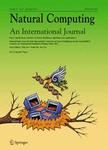版权所有:内蒙古大学图书馆 技术提供:维普资讯• 智图
内蒙古自治区呼和浩特市赛罕区大学西街235号 邮编: 010021

作者机构:Drake Univ Des Moines IA 50311 USA Iowa State Univ Ames IA 50011 USA Univ British Columbia Vancouver BC Canada
出 版 物:《NATURAL COMPUTING》 (自然计算)
年 卷 期:2024年第23卷第2期
页 面:365-385页
核心收录:
学科分类:08[工学] 0812[工学-计算机科学与技术(可授工学、理学学位)]
基 金:National Science Foundation [1900716, 1545028] Direct For Computer & Info Scie & Enginr Division of Computing and Communication Foundations Funding Source: National Science Foundation Division Of Computer and Network Systems Direct For Computer & Info Scie & Enginr Funding Source: National Science Foundation
主 题:Tile assembly Chemical reaction network Sierpinski triangle Sierpinski carpet Molecular programming language
摘 要:Schiefer and Winfree recently introduced the chemical reaction network-controlled tile assembly model (CRN-TAM), a variant of the abstract tile assembly model (aTAM). In the CRN-TAM, tile reactions are mediated via non-local chemical signals controlled by a chemical reaction network. This paper introduces ALCH, an imperative programming language for specifying CRN-TAM programs that can be compiled and simulated. ALCH includes standard language features such as Boolean variables, conditionals, loops, and CRN-TAM-specific constructs such as adding and removing tiles. ALCH also includes the branch and parallel structures which harness the nondeterministic and parallel nature of the CRN-TAM. ALCH also supports functional tileset specification. Using ALCH, we show that the discrete Sierpinski triangle and the discrete Sierpinski carpet can be strictly self-assembled in the CRN-TAM, which shows the CRN-TAM can self-assemble infinite shapes at scale 1 that the aTAM cannot. ALCH allows us to present these constructions at a high level, abstracting species and reactions into C-like code that is simpler to understand. We employ two new CRN-TAM techniques in our constructions. First, we use ALCH s nondeterministic branching feature to probe previously placed tiles of the assembly and detect the presence and absence of tiles. Second, we use scaffolding tiles to precisely control tile placement by occluding any undesired binding sites. This paper is an extension of our previous work, updated to include a Sierpinski carpet construction and the parallel command.